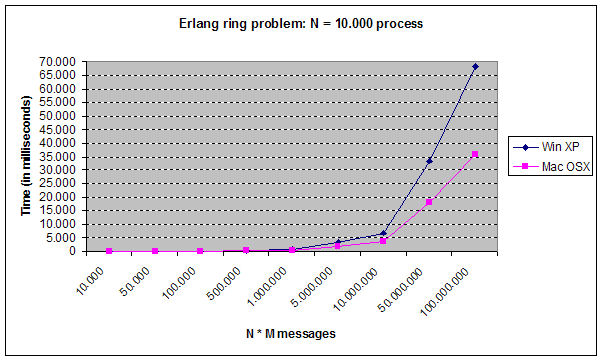Erlang ring problem
As I am on vacation, I have had some time to read part of the Programming Erlang book I mentioned some posts ago. After reading the firsts chapters, I was surprised to see that one of the not so much mentioned Erlang central features is that relies extremely on the pattern matching idiom. Just one example, the “=” operator is a pattern matching operator, which behaves like assignment when the variable is unbound, and act like a pattern matching expression when it is bound.
Another feature that I was glad to see is the actor model paradigm, with messages sent from and to Actors (like Scala or Smalltalk) to deal with highly complex concurrency models.
But after playing with some of the examples that appear on the book, I found this exercise at the end of the chapter 8 :
Write a ring benchmark. Create N processes in a ring. Send a message round the ring M times so that a total of N * M messages get sent. Time how long this takes for different values of N and M.
Ok, so here it is my solution (ring.erl):
-module (ring).
-export ([start/2]).
start(N, M) ->
statistics(runtime),
statistics(wall_clock),
Main_process = self(),
io:format("Creating ~p ring processes~n", [N]),
spawn(fun() -> ring(1, N, M, self(), Main_process) end),
receive
ended -> void
end,
{_, Time1} = statistics(runtime),
{_, Time2} = statistics(wall_clock),
U1 = Time1,
U2 = Time2,
io:format("Ring benchmark for ~p processes and ~p messages =
~p (~p) milliseconds~n", [N, M, U1, U2]).
ring(_, N, _, _, _) when(N =< 0)->
io:format("Empty ring~n"),
erlang:error(emptyRing);
ring(_, _, M, _, _) when(M =< 0)->
io:format("No messages to send~n"),
erlang:error(noMessagesToSend);
ring(N, N, M, First_process, Main_process) ->
io:format("Ring process ~p (~p) created~n", [N, self()]),
io:format("Sending ~p messages through the ring~n", [M]),
First_process ! {send, main_process, Main_process},
loop(M, N, N, First_process, Main_process);
ring(I, N, M, First_process, Main_process) ->
io:format("Ring process ~p (~p) created~n", [I, self()]),
Next_process = spawn(fun() ->
ring(I+1, N, M, First_process, Main_process) end),
loop(M, I, N, Next_process, Main_process).
loop(0, N, N, _, Main_process) ->
io:format("Ring process ~p (~p) finished~n", [N, self()]),
Main_process ! ended;
loop(0, I, _, _, _) ->
io:format("Ring process ~p (~p) finished~n", [I, self()]);
loop(M, I, N, Next_process, Main_process) ->
receive
{send, From, From_process} ->
io:format("Process ~p (~p) received message ~p
from process ~p (~p) ~n", [I, self(), M, From, From_process]),
Next_process ! {send, I, self()},
loop(M-1, I, N, Next_process, Main_process)
end.
And here the benchmark results based on Erlang R11B, two different configuration machines and running the above code but without I/O (ring_noio.erl):
- Mac OS-X 10.4.10:
- Processor: Intel Core 2 Duo Processor 2.2 GHz
- Memory: 2 Gb 667 MHz DDR2
- Windows XP Professional SP2:
- Processor: AMD Athlon 64 X2 Dual Core Processor 4200+ (working each core at 2.2 GHz)
- Memory: 2 Gb 667 MHz DDR2
The exercise illustrates how long it takes to spawn a large number of processes and the cost of message passing between them. There is no parallelism in this exercise, as there is only one process active at a time (the others are waiting for a message), but demonstrates how well Erlang can deal with lots of processes and lots of sending and receiving messages. Although I believe I need to do more serious tests, creating 10.000 process and passing 100 million messages in 35 seconds is a great mark.
The second part of the exercise is to write a similar program in some other programming language and to compare the results. Check these links to see some results:
- Performance Measurements of Threads in Java and Processes in Erlang
- Erlang vs. Stackless python: a first benchmark
- Benchmarking Java Vs Erlang
- Erlang, Termite and a Blog
- Erlang processes vs. Java threads
Next chapters: distributed programming, OTP and Mnesia (the Erlang Database).
Comments
Comment by Simon on 2007-08-30 07:48:07 +0000
Your solution is clearer to me than the one over at http://muharem.wordpress.com/ though I found that a very interesting article, too.
Thanks for this. I’m working my way through the book v-e-r-y slowly as coming from a purely flash development background almost all Erlang concepts are new on me.
But, damn, there’s just something about erlang that makes me want to learn it!
Comment by Ernest Micklei on 2008-05-27 14:22:04 +0000
Please have a look at my version:
http://philemonworks.wordpress.com/2008/05/23/ring-benchmark-my-first-concurrent-erlang/
I did not spend much time on gathering significant statistics. Getting a readable compact program was far more challenging.
Comment by David Grenier on 2011-06-11 03:22:52 +0000
Hello,
The following implementation in C# using Rx.NET runs in 1min58 in LINQPad on quad core Q6600@2.4ghz:
var listeners =
Enumerable.Range(0, 10000)
.Select(_ => new Subject(Scheduler.TaskPool))
.MemoizeAll();
listeners.Publish(o => o.Zip(o.Skip(1), (l, r) => new { l, r}))
.Run(o => o.l.Subscribe(o.r));
Observable
.Range(0, 10000)
.Delay(TimeSpan.FromMilliseconds(1000))
.Subscribe(listeners.First());
listeners.Last().Last().Dump();
I also have the following F# implementation running in 50s on the same machine (F# interactive):
type Agent = MailboxProcessor
let count = 10000
let now = System.DateTime.Now
Agent.Start (fun inbox ->
async {
while true do
let! msg = inbox.Receive()
if msg = count then
printfn “%A” (System.DateTime.Now – now).TotalMilliseconds })
|> Seq.unfold (fun next ->
let agent = Agent.Start (fun inbox ->
async {
while true do
let! msg = inbox.Receive()
next.Post msg } )
Some (agent, agent))
|> Seq.nth count
|> (fun agent -> for i in 1..count do agent.Post i)
Both code seems to scale pretty well versus the timing I had on my dual core laptop at work (T7400), although I only remember the time for the C#-Rx version at 5min50.
David







